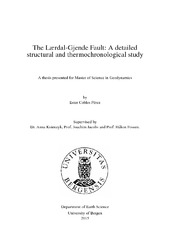| dc.description.abstract | The development of the Caledonian orogen to a passive margin leaded to the present-day Norwegian landscape. The most recent denudation history in Mesozoic and Cenozoic times holds the key to the morphotectonic development of southern Norway. The purpose of this study is to asses the inluence of the Lærdal-Gjende fault over the local exhumation pattern of the study area. The second part of the study encompasses a detailed structural analysis of the fault-rocks exposed in the Lærdalsøyri outcrop. Low-temperature thermochronology has become more popular among geologists over the last decades. Apatite ission track analysis (AFT) was performed for 10 of samples from the footwall and the hanging wall blocks of the Lærdal-Gjende fault. AFT ages from Permian to Middle Cretaceous times were revealed by AFT analysis using the external detector method. Most of the samples were collected from the footwall block and gave scattered AFT ages ranging from Middle Cretaceous to Early Jurassic. An trend of increasing AFT age towards the Lærdal-Gjende fault was discovered for the hanging wall. In opposite, a decreasing AFT age trend towards the fault was revealed for the footwall block. The local exhumation pattern corresponds to the ‘footwall uplift model’ proposed by Andersen et al. (1999). The thermal modeling was performed for 4 samples of the footwall block and suggest two accelerated cooling events from Late Carboniferous to Early Jurassic times and in Neogene times. In regional basis, the time-Temperature paths obtained can be linked to the rifting episodes of the North Sea and North Atlantic Ocean. The Hardangerfjord Shear Zone extends from the North Sea (SW) into mainland Norway (NE) and it is hard-linked to the Lærdal-Gjende fault in onshore. The post-Caledonian rifting episodes provoked the reactivation in diferent occasions of both the Hardangerfjord Shear Zone and the Lærdal-Gjende fault. Cooling rate estimates of <1,5 [ from Late Carboniferous to Early Jurassic times are signiicantly slower to cooling rates reported for coastal samples. This shows the importance of rift lank uplift during Mesozoic rifting in coastal areas. The Paleogene rapid cooling, however, is attributed to thermal disturbances derived from the opening of the North Atlantic Ocean. The Lærdalsøyri outcrop yields a wide span of fault rock types. The cataclasites of the hanging wall block show signs of ductile deformation overprint in upper amphibolite metamorphic conditions. That is interpreted to be the consequence of extensional displacement, that juxtaposed the cataclasites onto the mylonitic package from the footwall. That process represented an increase in temperature conditions. The exhumation of the hanging wall is evidenced by the retrometamorphism into greenschist facies. The thick package of medium to low-grade mylonites from the footwall block are associated to top-to-NW displacement of the Lærdal-Gjende fault during Devonian times. The fault core show diferent generations of fault gouges linked to Mesozoic brittle reactivation of the fault. | en_US |
